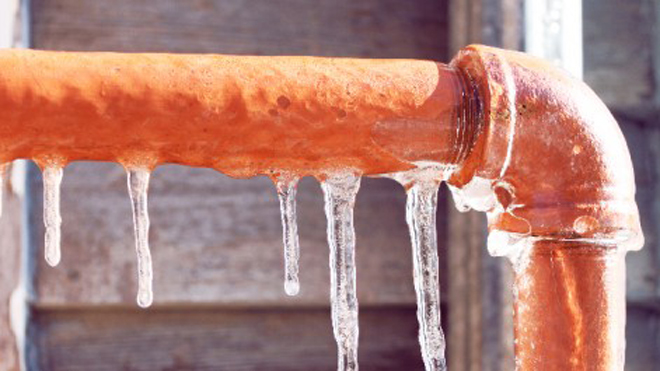Crucial Tips for Preventing Frozen Pipes in Cold Weather Conditions
Book-NowHow do you feel in regards to 6 Ways to Prevent Frozen Pipes?

Cold weather can wreak havoc on your plumbing, especially by freezing pipelines. Below's how to stop it from occurring and what to do if it does.
Intro
As temperatures decrease, the threat of frozen pipes increases, potentially causing costly fixings and water damage. Comprehending how to stop icy pipes is vital for property owners in cold environments.
Prevention Tips
Protecting susceptible pipes
Wrap pipelines in insulation sleeves or use heat tape to shield them from freezing temperatures. Concentrate on pipes in unheated or outside locations of the home.
Heating techniques
Keep interior areas effectively heated up, specifically areas with pipes. Open up cabinet doors to enable cozy air to distribute around pipelines under sinks.
How to determine frozen pipes
Look for lowered water flow from taps, unusual smells or sounds from pipes, and noticeable frost on revealed pipelines.
Long-Term Solutions
Structural modifications
Consider rerouting pipes far from exterior wall surfaces or unheated areas. Include added insulation to attics, basements, and crawl spaces.
Updating insulation
Purchase top quality insulation for pipelines, attic rooms, and wall surfaces. Proper insulation aids preserve consistent temperatures and lowers the danger of frozen pipelines.
Securing Outdoor Plumbing
Yard hose pipes and outdoor faucets
Separate and drain garden hoses prior to winter season. Set up frost-proof faucets or cover outdoor taps with protected caps.
Recognizing Icy Pipes
What causes pipes to freeze?
Pipes freeze when subjected to temperature levels below 32 ° F (0 ° C) for extended durations. As water inside the pipelines ices up, it broadens, taxing the pipeline walls and possibly causing them to rupture.
Risks and problems
Frozen pipes can cause water system disturbances, home damage, and expensive fixings. Burst pipes can flood homes and trigger substantial structural damages.
Signs of Frozen Pipeline
Recognizing icy pipes early can avoid them from rupturing.
What to Do If Your Pipelines Freeze
Immediate activities to take
If you think icy pipes, keep taps open up to alleviate pressure as the ice thaws. Use a hairdryer or towels taken in warm water to thaw pipelines gradually.
Final thought
Preventing frozen pipes needs aggressive actions and fast reactions. By recognizing the reasons, signs, and preventive measures, property owners can shield their pipes throughout winter.
6 Proven Ways to Prevent Frozen Pipes and Protect Your Home
Disconnect and Drain Garden Hoses
Before winter arrives, start by disconnecting your garden hoses and draining any remaining water. Close the shut-off valves that supply outdoor hose bibs and leave the outdoor faucet open to allow any residual water to drain. For extra protection, consider using faucet covers throughout the colder months. It’s also important to drain water from any sprinkler supply lines following the manufacturer’s directions.
Insulate Exposed Pipes
Insulating your pipes is an effective way to prevent freezing. Pipe insulation is readily available at home improvement stores and is relatively inexpensive. Pay close attention to pipes in unheated areas such as the attic, basement, crawl spaces, or garage. Apply foam insulation generously to create a buffer against the cold. You can also wrap your pipes in heat tape or thermostat-controlled heat cables for added warmth.
Seal Air Leaks
Inspect your home for any cracks or openings that could let in cold air. Seal any holes around the piping in interior or exterior walls, as well as the sill plates where your home rests on its foundation. Additionally, make sure to keep your garage door closed unless you’re entering or exiting. Leaving it open creates a significant air leak that can lead to frozen pipes.
Allow Warm Air Circulation
During cold snaps, it’s essential to allow warm air to circulate evenly throughout your home. Leave interior doors ajar to promote better airflow. Open kitchen and bathroom cabinets to help distribute heat consistently around the rooms. If you have small children or pets, be sure to remove any household chemicals or potentially harmful cleaners from open cabinets for safety.
Let Faucets Drip
A small trickle of water can make a big difference in preventing ice formation inside your pipes. When temperatures drop significantly, start a drip of water from all faucets served by exposed pipes. This continuous flow helps prevent the water from freezing. Additionally, running a few faucets slightly can relieve pressure inside the pipes, reducing the chances of a rupture if the water inside does freeze.
https://choateshvac.com/6-proven-ways-to-prevent-frozen-pipes-and-protect-your-home/

Hopefully you enjoyed our part about 6 Ways to Prevent Frozen Pipes. Thanks a lot for finding the time to browse our article. Those who appreciated our article please make sure you remember to share it. I cherish reading our article about 6 Ways to Prevent Frozen Pipes.
Browse Website